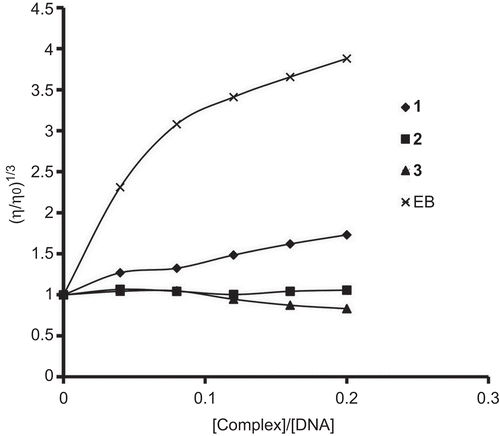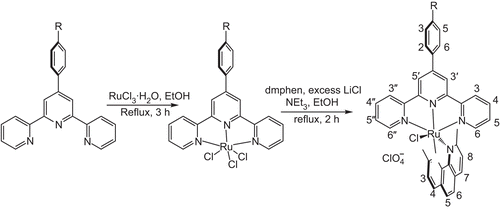Figures & data
Table 1. Electronic spectral data for the ruthenium(II) complexes.
Figure 1. Electronic absorption spectra of (A) [RuII(4-bptpy)(dmphen)Cl]ClO4, (B) [RuII(4-fptpy)(dmphen)Cl]ClO4 and (C) [RuII(4-mptpy)(dmphen)Cl]ClO4 with increasing amount of DNA in phosphate buffer (Na2HPO4/NaH2PO4, pH 7.2). [Complex] = 20 µM, [DNA] = 0–16.6 µM with incubation period of 15 min at 37°C. Plots of [DNA]/(ϵa− ϵf) versus [DNA] for the titration of DNA with RuII complexes.
![Figure 1. Electronic absorption spectra of (A) [RuII(4-bptpy)(dmphen)Cl]ClO4, (B) [RuII(4-fptpy)(dmphen)Cl]ClO4 and (C) [RuII(4-mptpy)(dmphen)Cl]ClO4 with increasing amount of DNA in phosphate buffer (Na2HPO4/NaH2PO4, pH 7.2). [Complex] = 20 µM, [DNA] = 0–16.6 µM with incubation period of 15 min at 37°C. Plots of [DNA]/(ϵa− ϵf) versus [DNA] for the titration of DNA with RuII complexes.](/cms/asset/3f89c834-d951-4afd-ace0-bef862654273/ienz_a_570007_f0002_b.gif)
Table 2. Electronic absorption data upon addition of Herring Sperm DNA.
Figure 2. Effect on relative viscosity of DNA under the influence of increasing amount of ethidium bromide and complexes at 27 ± 0.1°C in phosphate buffer (Na2HPO4/NaH2PO4, pH 7.2).

Figure 3. Agarose gel (1%) of pUC19 (100 µg/mL) incubated for 2 h at 37°C in TE buffer (pH 8) with increasing concentrations of the [RuII(4-bptpy)(dmphen)Cl]ClO4. Lane 1, DNA control; lane 2, RuCl3 (100 µM); lanes 3–8, [RuII(4-bptpy)(dmphen)Cl]ClO4 complex: 25, 75, 125, 200, 300 and 400 µM, respectively.
![Figure 3. Agarose gel (1%) of pUC19 (100 µg/mL) incubated for 2 h at 37°C in TE buffer (pH 8) with increasing concentrations of the [RuII(4-bptpy)(dmphen)Cl]ClO4. Lane 1, DNA control; lane 2, RuCl3 (100 µM); lanes 3–8, [RuII(4-bptpy)(dmphen)Cl]ClO4 complex: 25, 75, 125, 200, 300 and 400 µM, respectively.](/cms/asset/d798c3dc-2fc0-4a57-88ba-48efab76a086/ienz_a_570007_f0004_b.gif)
Figure 4. The percentage of SC, OC and L forms of DNA produced by various concentration of [RuII(4-bptpy)(dmphen)Cl]ClO4 complex.
![Figure 4. The percentage of SC, OC and L forms of DNA produced by various concentration of [RuII(4-bptpy)(dmphen)Cl]ClO4 complex.](/cms/asset/a2add36a-586a-4277-a40e-9c5608f7f92a/ienz_a_570007_f0005_b.gif)
Figure 5. Agarose gel (1%) of pUC19 (100 µg/mL) at 37°C in TE buffer (pH 8) with 200 µM [RuII(4-bptpy)(dmphen)Cl]ClO4 complex for increasing reaction time. Lane 1, DNA control; lanes 2–8: 15, 30, 60, 90, 120, 180 and 240 min, respectively.
![Figure 5. Agarose gel (1%) of pUC19 (100 µg/mL) at 37°C in TE buffer (pH 8) with 200 µM [RuII(4-bptpy)(dmphen)Cl]ClO4 complex for increasing reaction time. Lane 1, DNA control; lanes 2–8: 15, 30, 60, 90, 120, 180 and 240 min, respectively.](/cms/asset/d49d4a0e-e734-4faf-94cd-762a055c16cc/ienz_a_570007_f0006_b.gif)

![Figure 6. The percentage of SC, OC and L forms of DNA produced by 200 µM of [RuII(4-bptpy)(dmphen)Cl]ClO4 complex at different time.](/cms/asset/953c893c-f264-4d74-9e61-f4248512c5d9/ienz_a_570007_f0007_b.gif)
![Figure 7. Agarose gel (1%) of pUC19 (100 µg/mL) at 37°C in TE buffer (pH 8) with 200 µM compounds incubated for 4 h. Lane 1, DNA control; lane 2, RuCl3; lane 3, [RuII(4-bptpy)(dmphen)Cl]ClO4; lane 4, [RuII(4-fptpy)(dmphen)Cl]ClO4; lane 5, [RuII(4-mptpy)(dmphen)Cl]ClO4.](/cms/asset/53f93d64-968a-4654-9736-cf0216a61ebb/ienz_a_570007_f0008_b.gif)